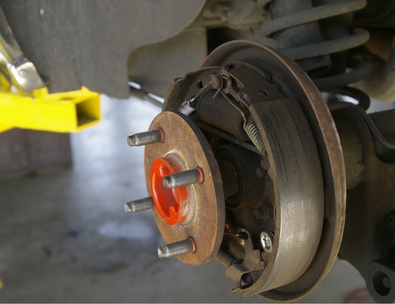
Wheel cylinders come as standard equipment on most rear wheels on newer cars. The only exceptions include much older vehicles that had wheel cylinders on the front and rear, and some of the high-performance sports vehicles that have calipers and disc brakes on the front and rear. The wheel cylinders, which contain pistons, cups and springs, have the unique design feature that allows them to be rebuilt with the correct replacement parts. This saves money that might have been spent on a new wheel cylinder. With a few tools and easy steps, the do-it-yourself repair person can perform the rebuilding task.
Pull the slotted piston rods out of the wheel cylinder dust boots and place the front rod on the left of you and the right rod on your right so you know which piston rod goes into what side. Pull the rubber dust boots off the wheel cylinder ends--they will pop off from the grooved lips .
Push your finger through one side of the wheel cylinder bore to force out the parts. From the end to the interior will be the cylinder piston, rubber cylinder cup, spring seat and the compression ring. Each side of the wheel cylinder has identical parts.
Clean the inside and outside of the wheel cylinder with carburetor cleaner and a rag. Wipe down the brake backing plate, if you wish the entire area clean. Insert an inside micrometer into the wheel cylinder bore and adjust the gauge tips until they contact the cylinder bore walls. Move the micrometer back in forth inside the bore until the gauge tips move with a slight drag from the front of the cylinder to the back.
Read the micrometer gauge for the number recorded in thousandths of an inch. Refer to your owner's repair manual for the maximum allowed diameter thickness of your wheel cylinder bore. You will now have the manufacturer's specification number and the number you have on your dial.
Compare the numbers. If your measurement reads within specifications, you can hone the cylinder out. Place a wheel cylinder hone bit in a drill motor. It does not matter if your hone bit has the three-arm configuration or small sanding balls. Dampen the inside of the wheel cylinder bore with brake fluid. Insert the cylinder hone through one open end of the cylinder bore and turn the drill on.
Make swift back and forth movements with the hone as it rotates inside the cylinder bore. Hold you fingers over the opposite end of the cylinder bore to keep the hone head from popping out. Pull the cylinder hone out after about 15 seconds and check the smoothness of the cylinder bore with your finger. If it feels smooth and clean, insert the micrometer inside the bore and take another measurement.
Make certain the cylinder bore thickness does not exceed the manufacture's specifications. If it appears too close, refrain from any more honing. Wipe out the inside of the cylinder bore with carburetor cleaner and a rag. Open the wheel cylinder rebuilding kit and arrange the parts in the order in which you will install them. Start first by inserting the compression spring inside the cylinder. Place two spring seats on both ends of the compression spring.
Insert two rubber piston cups inside the cylinder on both ends of the spring seat. Important: make sure the concave portion of the cups are facing inward toward the compression spring. Place the cylinder pistons on both ends of the piston cups -- you might have to hold them in from both ends by spreading your thumb and forefinger over both bore holes.
Slip the rubber dust boots over the wheel cylinder ends, snapping them back into their lip grooves. Put each slotted piston back into the center holes of the rubber dust boots, on their respective side.